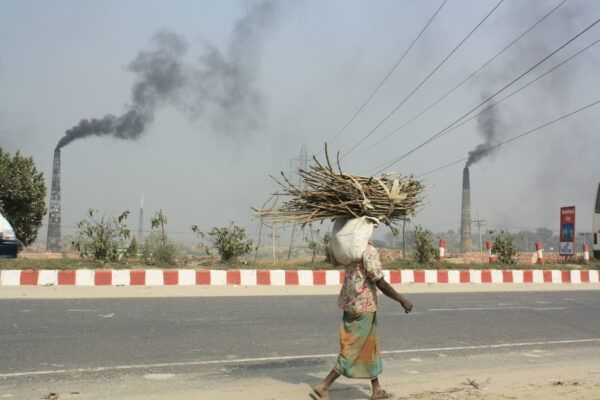As the world’s governments meet in Baku for COP29, a potent greenhouse gas remains largely absent from the climate agenda. Tropospheric ozone is responsible for approximately 0.23°C of present-day warming and more than half a million premature deaths each year. It is one of the super pollutants that have driven half of global warming to date. Now is the time for fast and integrated action to tackle this local and global challenge.
Our new policy brief sets out how reducing this super pollutant will mitigate climate change, deliver clean air and support food security.
What is tropospheric ozone?
Tropospheric ozone is a greenhouse gas that is also a harmful air pollutant. It is not emitted like many other gases and particles. Instead, it is formed in the atmosphere when sunlight interacts with a suite of other pollutants. The main ingredients driving elevated levels of this toxic gas are methane – a potent greenhouse gas – and nitrogen oxides, non-methane volatile organic compounds, and carbon monoxide – all harmful air pollutants. These ‘precursors’ are emitted from a range of sectors, including transport, industry, livestock and energy generation, as well as wildfires.
High levels of tropospheric ozone are harmful to people and planet. Tropospheric ozone drives the greenhouse gas effect, contributing to global warming and regional climate effects. At ground level, inhaling it leads to respiratory and other health issues. When over farmland, it disrupts the growth of staple crops, like wheat and maize.
The links between tropospheric ozone and other pollutants present a unique challenge for scientists and policy makers. Tropospheric ozone levels will respond in complex ways to changes in emissions. These dynamics play out differently over cities, suburbs, industrial areas, as well as at the global scale.
Explainer: ‘Good’ ozone versus ‘bad’ ozone
Ozone can mainly be found in two layers of the earth’s atmosphere. Tropospheric ozone, or ‘bad’ ozone, refers to ozone that is present in the atmosphere up to about 15 kilometers above ground-level. In this layer, ozone acts as a greenhouse gas and super pollutant, contributing significantly to global warming by absorbing infrared radiation and thereby heating the surrounding air. At the bottom of this layer – the earth’s surface – tropospheric ozone is often referred to as ‘ground-level ozone’. Here, it is responsible for almost half a million premature deaths per year and substantial reductions in agricultural crop yields.
Ozone plays a very different role in the stratosphere – the layer of the atmosphere from approximately 15 to 40 kilometers above the earth’s surface. Here, ozone protects us by absorbing harmful ultraviolet radiation through the ozone layer. This is the ‘good’ ozone layer that is protected by the internationally negotiated Montreal Protocol.
Stratospheric (‘good’) and tropospheric (‘bad’) ozone are interlinked. The good news is that we can simultaneously protect the beneficial ozone layer, while acting to reduce harmful tropospheric ozone levels.
Success stories show a triple win is possible
Despite the complexities around tropospheric ozone, progress is possible. Reducing it is a unique opportunity to secure benefits for climate, public health and agriculture.
This policy brief showcases efforts in cities and regions – including Los Angeles, Mexico City, Beijing and Europe – that have successfully reduced levels of tropospheric ozone through targeted pollution control. These success stories show us by leveraging the right tools it is possible to reduce tropospheric ozone and reap the many benefits of cleaner air and a healthier environment. The growing momentum on cutting methane emissions also presents a major opportunity for tackling tropospheric ozone at the global scale through an integrated approach.
These case studies highlight the importance of tackling climate change and air pollution collectively, as well as the need for coordinated efforts from cities up to the global level. Yet despite tropospheric ozone’s dual impact as an air pollutant and a greenhouse gas, the climate benefit of reducing ozone is often overlooked by governments.
The IPCC has long reported on the pollutant’s role in climate change and is currently developing new guidance for countries to report on their tropospheric ozone precursor emissions, as well as other air pollutants. This week, the US and China hosted the Summit on Methane and Non-CO2 Greenhouse Gases at COP29, where tropospheric ozone was highlighted as a priority issue. Remarks from John Podesta, Special Envoy for Climate for the US, and his counterpart in China, Liu Zhenmin, represent a step towards giving the issue the attention it needs on the global stage.
An opportunity for leadership on climate and health
Several governments have already taken important steps towards addressing this problem. South Africa, China and others have set standards for tropospheric ozone aligned the World Health Oganization’s (WHO) guidelines and interim targets. The US, the European Union and others have committed to the Gothenburg Protocol, with a key aim to tackle ozone at ground level. Mexico and others are reporting on their tropospheric ozone precursors alongside their greenhouse gas emissions to the UNFCCC. And 158 governments and rising are signatories to the Global Methane Pledge.
As the climate crisis worsens in 2024 and beyond, governments must make smarter decisions to tackle multiple problems together. Leaders must draw the crucial link between air pollution and climate change and translate that into an effective approach to tackling tropospheric ozone.
What next?
We need to raise this issue up the global agenda at key forums, such as COP29. We also need to support research on fundamental questions like understanding what additional actions we can take on tropospheric ozone precursors to get on-track for limiting warming at 1.5°C. And we need fast action on tropospheric ozone and all other climate super pollutants to mitigate climate change in time.
Clean Air Fund and partners plan to bring together the global climate and clean air community to co-design a blueprint for moving this conversation and action forward. If you’re interested, check out the Action on Tropospheric Ozone Pavilion.


